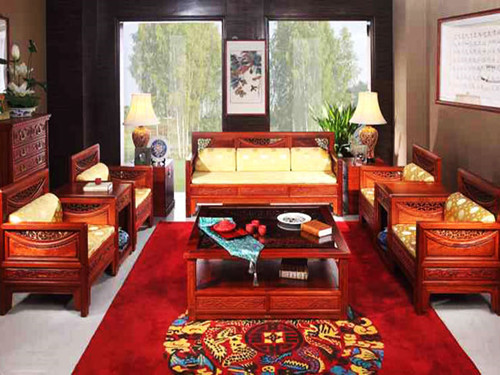
To mention Dongyang, I believe that most people think of mahogany furniture first.
Dongyang's mahogany furniture industry is mainly distributed in areas such as Dongyang City, Hengdian, Nanma, Dalian, Nanshi and Huashui. According to preliminary statistics, there are more than 4,000 mahogany furniture manufacturers in Dongyang, and this industry has become one of the leading industries in Dongyang.
The problem of environmental pollution brought about by so many mahogany furniture factories is worrying.
According to statistics, in the year of 2014, Dongyang Environmental Protection Bureau accepted 207 environmental petitions for the mahogany furniture industry, accounting for 24.9% of the total petitions. The major problems involved are pollution of wastewater, exhaust gas, and noise.
In particular, due to the unreasonable location of some mahogany furniture and ancillary processing companies, they are mainly scattered in many villages, causing pollution in the production process to have a greater impact on nearby residents, and the surrounding villagers have reported very large amounts.
According to the Dongyang Environmental Protection Bureau, the redwood pollution rectification has no time to delay.
As early as 2014, Dongyang City transferred personnel from the public security, environmental protection, forestry, and other departments to set up 10 special inspection teams to promote the renovation of the mahogany furniture industry. There were 388 mahogany enterprises shutting down or relocating due to “three reforms and one demolitionâ€, 404 were banned due to unlicensed and unlicensed operations, 655 were suspended from production due to lack of the most basic production conditions, and there were more than 1,000. Due to the existence of fire, dust, electricity, environmental protection and other safety issues for a deadline for rectification.
Among them, the causes of illegal environmental pollution are also varied.
“Some enterprises do not have the approval conditions to complete the production without authorization; some enterprises do not have supporting facilities for pollution control, the operation and management are not in place, and there are many phenomena of excessive discharge of pollutants.†The relevant staff of Dongyang Environmental Protection Bureau stated that these phenomena are related to the new “Environmental Protection The law is out of place.
How to rectify
Dongyang Environmental Protection Bureau drafts a detailed plan
In order to solve the problem of pollution of mahogany furniture companies, Dongyang City Environmental Protection Agency has recently formulated a detailed remediation program. Through environmental remediation, we will basically solve the problems of low (low level of technology), scattered (excessive dispersion) and poor (poor management level), and promote the standardization, health, and sustainable development of the mahogany furniture industry in Dongyang City. Dongyang City Environmental Protection Bureau staff said that the main work is still on the preparation of early services and related norms. "While waiting for the next step of propaganda and technology are in place, for those heavily polluting redwood enterprises, the handling of the treatment should be shut down."
1. Wastewater Pollution Prevention and Control
The implementation of cleaning and diversion, rain and sewage diversion. The production and management are divided into products and sub-regions in the plant area. Waste water such as sawdust wastewater, drying and cooking effluent, bleaching effluent, mahogany leaching water, and leachate from mahogany yard are collected and sent to the sewage treatment system to be treated and discharged. Unmanaged lacquered mahogany furniture companies must meet the first-grade standard in the Integrated Wastewater Discharge Standard (GB8978-1996) for waste water discharged into the environment; in principle, the management companies should perform pretreatment to achieve the standard of management and discharge into the sewage treatment plant for centralized treatment. . At the same time, enterprises are encouraged to entrust qualified and processing third parties to collect and handle them in a unified manner.
2. Atmospheric pollution prevention and control
(1) Boiler. The centralized area of ​​mahogany furniture encourages the implementation of centralized district heating and promotes the use of clean energy. 6 Steam ton (6 tons of steam per hour) The following combustion boilers must be completely phased out by the end of December 2015. The new batch of boilers must meet the relevant requirements. If there is no centralized heating condition, the rejection rate of coal-fired boilers above 35t/h shall not be lower than 90%, and the rejection rate below 35t/h shall not be lower than 60%, and the air pollutant discharge standard of boilers must be met. (GB13271-2014) and total control requirements.
(2) Workshop dust. The dust-generating processes and workshops for opening materials, carpentry, polishing and grinding must be equipped with dust absorption devices, and discharged after being treated to achieve the comprehensive emission standards for air pollutants (GB16297-1996).
(3) paint exhaust. The organic waste gas production process such as lacquer coating and painting, as well as the workshop must be equipped with an exhaust gas treatment device, and discharged after being treated to achieve the comprehensive discharge standard for air pollutants (GB16297-1996).
3, solid waste
Collect and collect solid wastes and standardize them. The general temporary storage of solid waste and hazardous solid waste respectively meets the "General Industrial Waste Storage and Disposal Pollution Control Standards" and "Hazardous Waste Storage Pollution Control Standards" requirements. Wood chips, scraps, etc. are not permitted to be stored in the open air; waste paint buckets containing or directly contaminating paint residues are hazardous wastes and should be disposed of by qualified personnel.
4, noise
Use low noise equipment and layout. Noise suppression and noise reduction measures shall be taken for high noise sources, and daily maintenance of noise prevention and control facilities shall be strengthened. Ensure that the noise at the plant boundary meets the environmental noise emission standards for industrial enterprises (GB12348-2008).
Wood Stove,Fireplace Wood Stove,Wood Stove Heater,Steel Fireplace Wood Stove
JINAN LODOR CNC EQUIPMENT CO.,LTD , https://www.zgfireplace.com